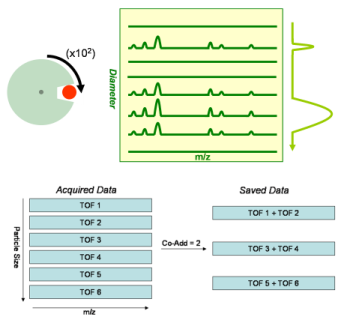As shown in the figure below, the PToF data set is a matrix with rows corresponding to TOF extractions. We call this data matrix (yellow region) the chopper block.

The start of a chopper cycle is triggered at the moment when the chopper slit passes the axis of the particle beam. The first row row of the acquired block is the first TOFMS recorded after the chopper trigger, the second row is the second TOFMS recorded, and so on.
For Single Particle modes the block contains data for a single chopper cycle. For PToF Mode, the chopper block is the average of many chopper cycles. (The number of cycles averaged in a single file depends on dwell time and save time settings.) In all acquisition modes, full waveforms are stored in the memory of the AP240 before transfer to the PC. For PToF mode, the ADC averages multiple cycles before transfer to the PC.
Like all storage devices, the ADC has finite memory and can only store a limited amount of data. For the ToF-AMS the limit is 4M samples per acquisition. The total number of data values in the acquired block is the product of the number of samples/TOF (length of TOF waveform) and the TOF/chop (number of rows in block).
As you can see in the figure, the number of samples/TOF determines the mass range and the TOF/chop determines the particle size range. If you desire an extended mass range and/or size range the total number of samples may grow very large. The DAQ will warn you if your settings exceed 4M samples. Short of that, you should also consider that a large number of samples yields large PTOF file size.
Co-Adding allows us to extend mass and size range to a point where the product of numSamples and TOF/Chop is greater than 4M, while keeping the memory used on the AP240 (and the number of samples in the data file) below 4M samples.
To understand co-adds, we differentiate between the acquisition block from the save block, as shown in the second part of the figure above. Both blocks will have number of columns equal numSamples, but the co-add blocks has a reduced number of rows. Specifically, the number of rows = (TOF/chop)/2. It accomplishes this by averaging successive TOF/extraction within the block.
The advantage of co-adding is the ability to acquire PToF data across large mass and/or size range with reduced ADC memory usage. This is mandatory in some circumstance. And, in all situations it will improve efficiency (less data to transfer and write to disk) and reduce file size.
Keep in mind, though, that the because co-adding averages successive rows of the acquired block, the resolution of the PToF measurement is reduced.



No comments:
Post a Comment